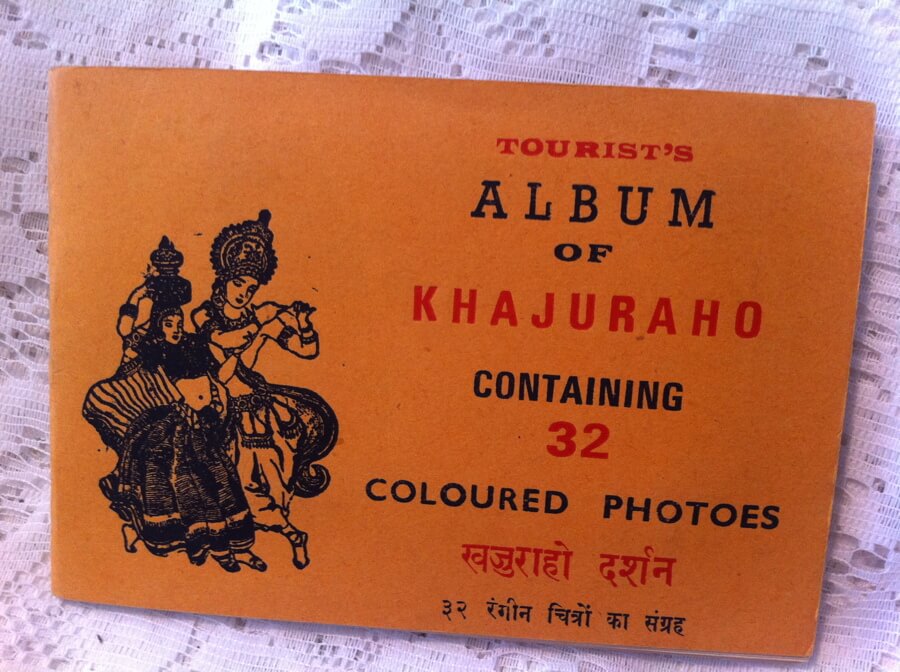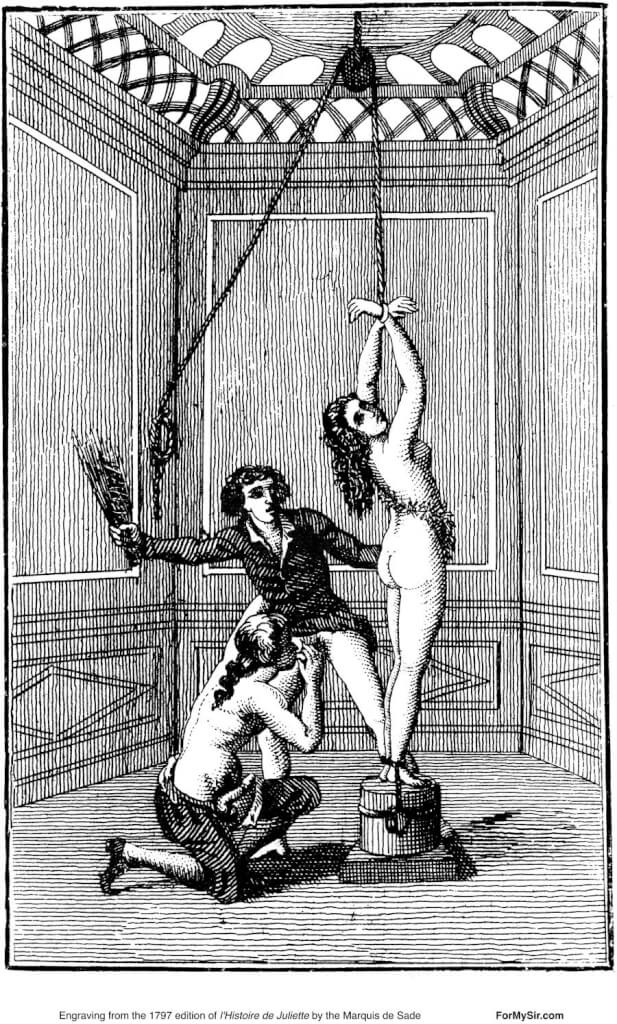-

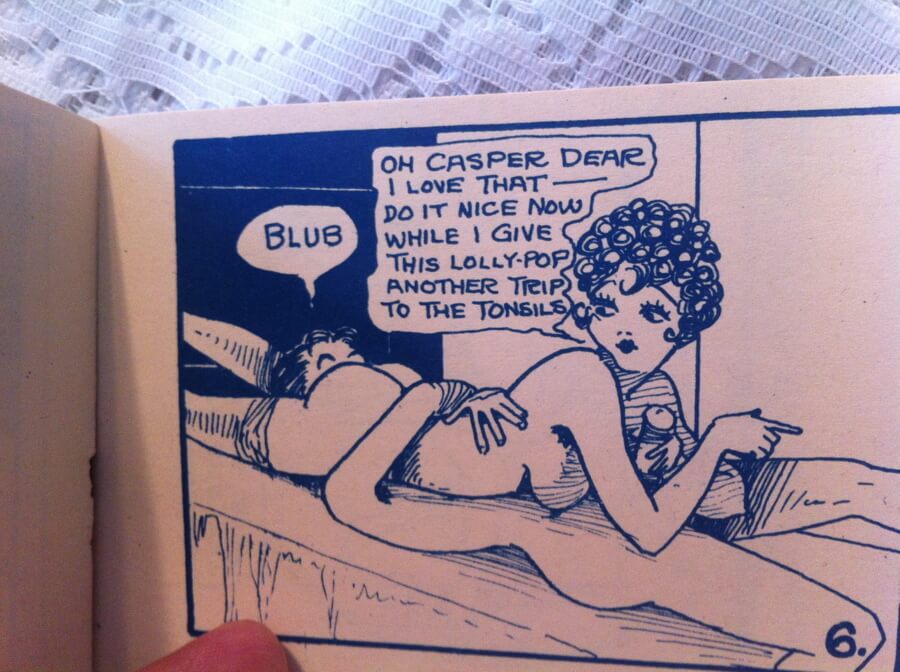 Toots and Casper in "A Little Variety", (n.p. n.d.) 4.5" x 3", 8pp. pamphlet, stapled, middle page loose Tijuana bibles (also known as eight-pagers, bluesies, gray-backs, Jiggs-and-Maggie books, jo-jo books, Tillie-and-Mac books, and two-by-fours) were little pornographic comic books produced in the United States from the 1920s to the early 1960s. Their popularity peaked during the Great Depression era. This book parodies Toots and Casper, a long running family comic strip from 1918 to 1956.
Toots and Casper in "A Little Variety", (n.p. n.d.) 4.5" x 3", 8pp. pamphlet, stapled, middle page loose Tijuana bibles (also known as eight-pagers, bluesies, gray-backs, Jiggs-and-Maggie books, jo-jo books, Tillie-and-Mac books, and two-by-fours) were little pornographic comic books produced in the United States from the 1920s to the early 1960s. Their popularity peaked during the Great Depression era. This book parodies Toots and Casper, a long running family comic strip from 1918 to 1956. -
Out of stock

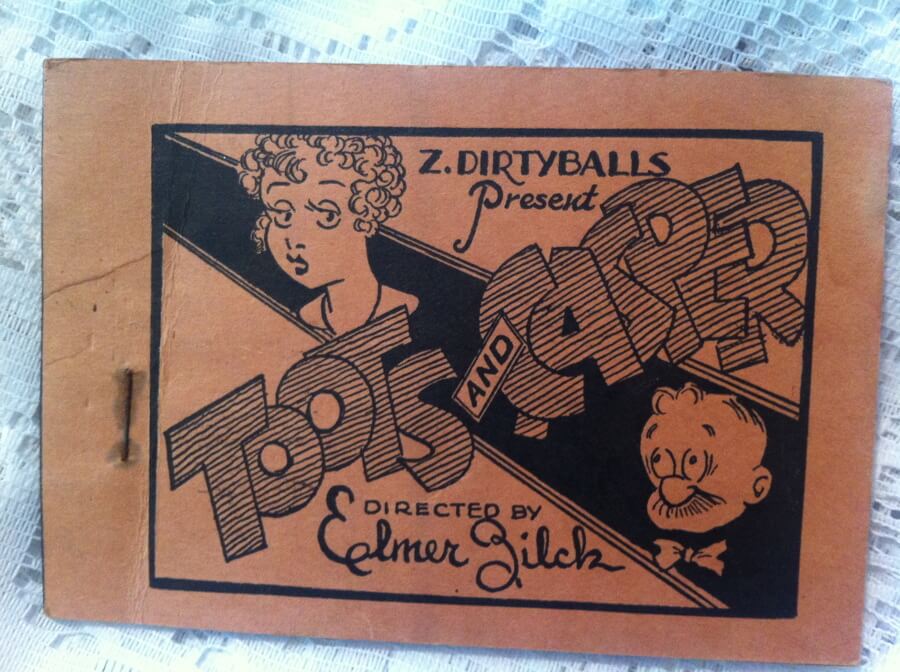 Z. Dirtyballs Present Toots and Casper, "directed by Elmer Zilch" (n.p. n.d.) 4.5" x 3", 8pp. pamphlet, stapled Tijuana bibles (also known as eight-pagers, bluesies, gray-backs, Jiggs-and-Maggie books, jo-jo books, Tillie-and-Mac books, and two-by-fours) were little pornographic comic books produced in the United States from the 1920s to the early 1960s. Their popularity peaked during the Great Depression era. This book parodies Toots and Casper, a long running family comic strip from 1918 to 1956.
Z. Dirtyballs Present Toots and Casper, "directed by Elmer Zilch" (n.p. n.d.) 4.5" x 3", 8pp. pamphlet, stapled Tijuana bibles (also known as eight-pagers, bluesies, gray-backs, Jiggs-and-Maggie books, jo-jo books, Tillie-and-Mac books, and two-by-fours) were little pornographic comic books produced in the United States from the 1920s to the early 1960s. Their popularity peaked during the Great Depression era. This book parodies Toots and Casper, a long running family comic strip from 1918 to 1956. -
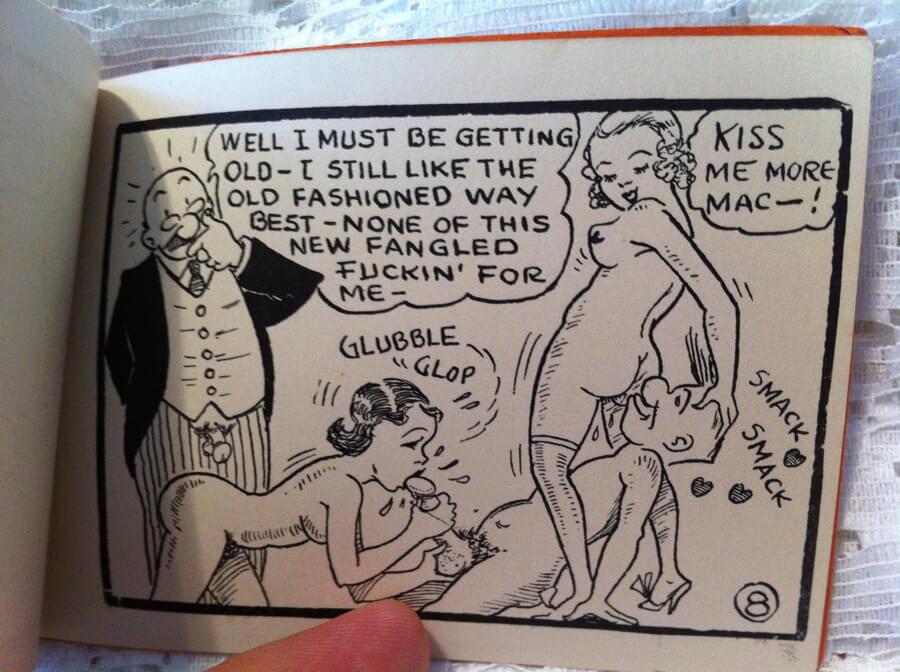
 Tillie and Mac with Mr. Simpkins and Bubbles, (n.p. n.d.) 4.5" x 3", 8pp. pamphlet, stapled Tijuana bibles (also known as eight-pagers, bluesies, gray-backs, Jiggs-and-Maggie books, jo-jo books, Tillie-and-Mac books, and two-by-fours) were little pornographic comic books produced in the United States from the 1920s to the early 1960s. This parodies "Tillie the Toiler", a popular newspaper comic strip from 1921 to 1959.
Tillie and Mac with Mr. Simpkins and Bubbles, (n.p. n.d.) 4.5" x 3", 8pp. pamphlet, stapled Tijuana bibles (also known as eight-pagers, bluesies, gray-backs, Jiggs-and-Maggie books, jo-jo books, Tillie-and-Mac books, and two-by-fours) were little pornographic comic books produced in the United States from the 1920s to the early 1960s. This parodies "Tillie the Toiler", a popular newspaper comic strip from 1921 to 1959. -
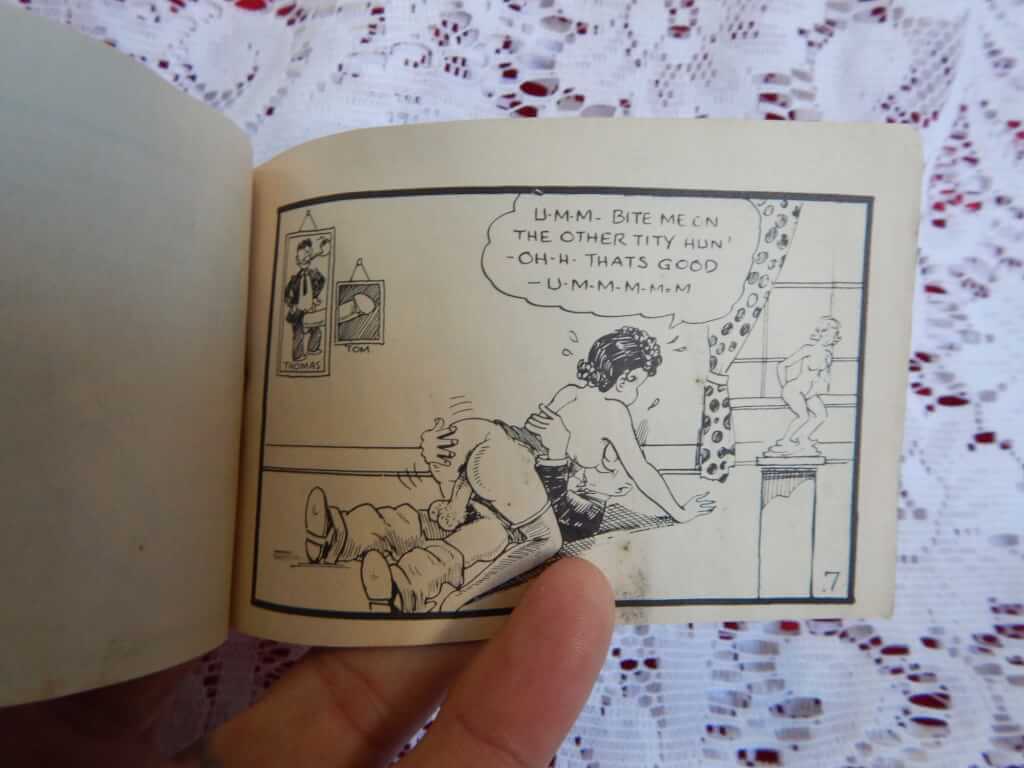
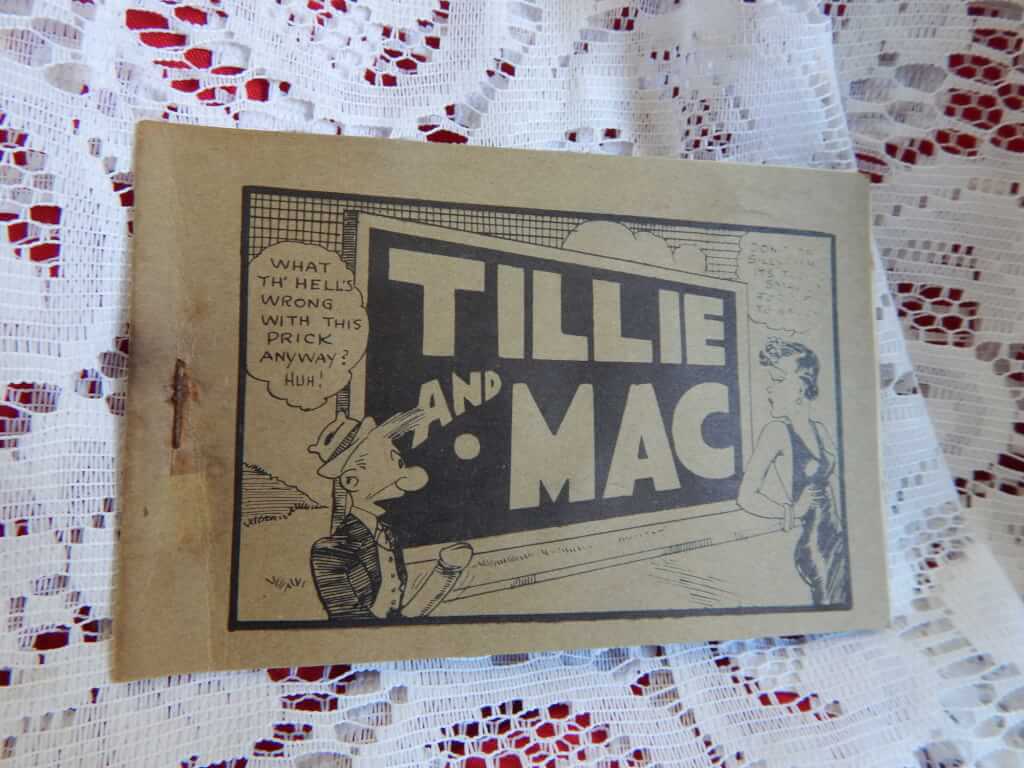 Tillie and Mac, (n.p. n.d.) 4.5" x 3", 8pp. pamphlet, stapled Tijuana bibles (also known as eight-pagers, bluesies, gray-backs, Jiggs-and-Maggie books, jo-jo books, Tillie-and-Mac books, and two-by-fours) were little pornographic comic books produced in the United States from the 1920s to the early 1960s. This parodies "Tillie the Toiler", a popular newspaper comic strip from 1921 to 1959.
Tillie and Mac, (n.p. n.d.) 4.5" x 3", 8pp. pamphlet, stapled Tijuana bibles (also known as eight-pagers, bluesies, gray-backs, Jiggs-and-Maggie books, jo-jo books, Tillie-and-Mac books, and two-by-fours) were little pornographic comic books produced in the United States from the 1920s to the early 1960s. This parodies "Tillie the Toiler", a popular newspaper comic strip from 1921 to 1959. -
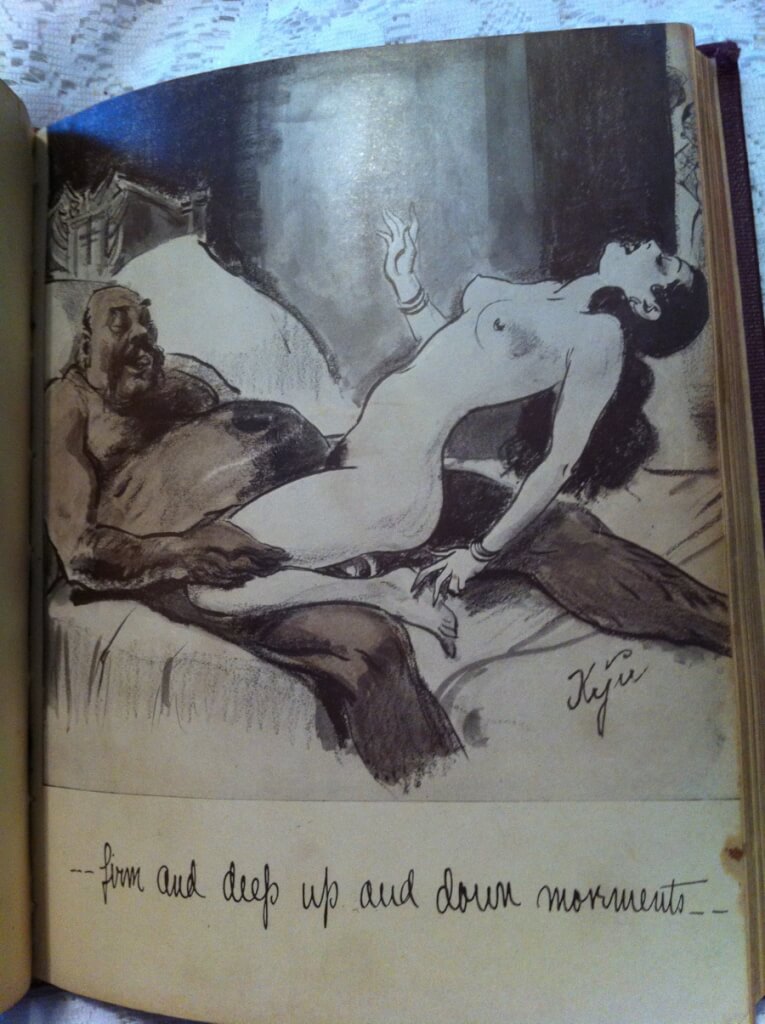
 Three Times a Woman, Grushenka, anonymous [possibly Val Lewton?], illus. "a young Russian residing in Paris, who unfortunately must remain anonymous" (Privately Printed, London [New York], 1933) 9" X 7", 252pp, hardbound no DJ, red boards with gilt title on cover and spine, good condition, minor wear and bumping. Title page reads: "The Story of a Russian Serf Girl Compiled from Contemporary Documents in the Russian Police Files and Private Archives of Russian Libraries" Originally published at New York in 1933 with a false Paris imprint. Val Lewton, the supposed author, was a well known film producer, responsible for a series of good low-budget horror movies in the 1940's by such directors as Robert Wise, Mark Robson and Jacques Tourneur. The book purports to be a flaggelation story written by a Russian living in Paris and then translated to english. The story takes place c. 1728, "shortly after the death of Peter the Great". The main character is Grushenka Pavlovsk. This edition is complete with very explicit illustrations.
Three Times a Woman, Grushenka, anonymous [possibly Val Lewton?], illus. "a young Russian residing in Paris, who unfortunately must remain anonymous" (Privately Printed, London [New York], 1933) 9" X 7", 252pp, hardbound no DJ, red boards with gilt title on cover and spine, good condition, minor wear and bumping. Title page reads: "The Story of a Russian Serf Girl Compiled from Contemporary Documents in the Russian Police Files and Private Archives of Russian Libraries" Originally published at New York in 1933 with a false Paris imprint. Val Lewton, the supposed author, was a well known film producer, responsible for a series of good low-budget horror movies in the 1940's by such directors as Robert Wise, Mark Robson and Jacques Tourneur. The book purports to be a flaggelation story written by a Russian living in Paris and then translated to english. The story takes place c. 1728, "shortly after the death of Peter the Great". The main character is Grushenka Pavlovsk. This edition is complete with very explicit illustrations. -

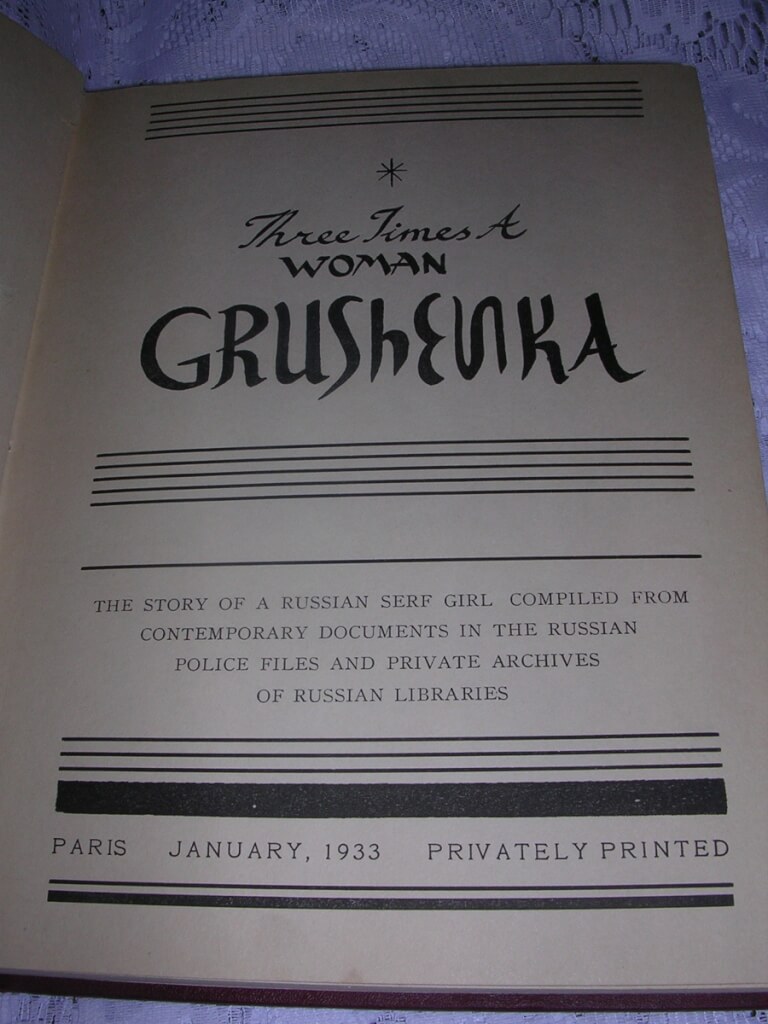 Three Times a Woman, Grushenka, anonymous [possibly Val Lewton?], illus. "a young Russain residing in Paris, who unfortunately must remain annonymous" (Privately Printed, London [New York], 1933 [probably a reprint as it does not have illustrations of the original]) 9 7/8" X 6 7/8", 252pp, hardbound no DJ, red boards with gilt title on spine, good condition, minor wear and bumps to cover, binding tight, bookplate of Erwin A. Weiss, D.D.S. Title page reads: "The Story of a Russian Serf Girl Compiled from Contemporary Documents in the Russian Police Files and Private Archives of Russian Libraries" Originally published at New York in 1933 with a false Paris imprint. Val Lewton, the supposed author, was a well known film producer, responsible for a series of good low-budget horror movies in the 1940's by such directors as Robert Wise, Mark Robson and Jacques Tourneur. The book purports to be a flaggelation story written by a Russian living in Paris and then translated to english. The story takes place c. 1728, "shortly after the death of Peter the Great". The main character is Grushenka Pavlovsk.
Three Times a Woman, Grushenka, anonymous [possibly Val Lewton?], illus. "a young Russain residing in Paris, who unfortunately must remain annonymous" (Privately Printed, London [New York], 1933 [probably a reprint as it does not have illustrations of the original]) 9 7/8" X 6 7/8", 252pp, hardbound no DJ, red boards with gilt title on spine, good condition, minor wear and bumps to cover, binding tight, bookplate of Erwin A. Weiss, D.D.S. Title page reads: "The Story of a Russian Serf Girl Compiled from Contemporary Documents in the Russian Police Files and Private Archives of Russian Libraries" Originally published at New York in 1933 with a false Paris imprint. Val Lewton, the supposed author, was a well known film producer, responsible for a series of good low-budget horror movies in the 1940's by such directors as Robert Wise, Mark Robson and Jacques Tourneur. The book purports to be a flaggelation story written by a Russian living in Paris and then translated to english. The story takes place c. 1728, "shortly after the death of Peter the Great". The main character is Grushenka Pavlovsk. -
Out of stock
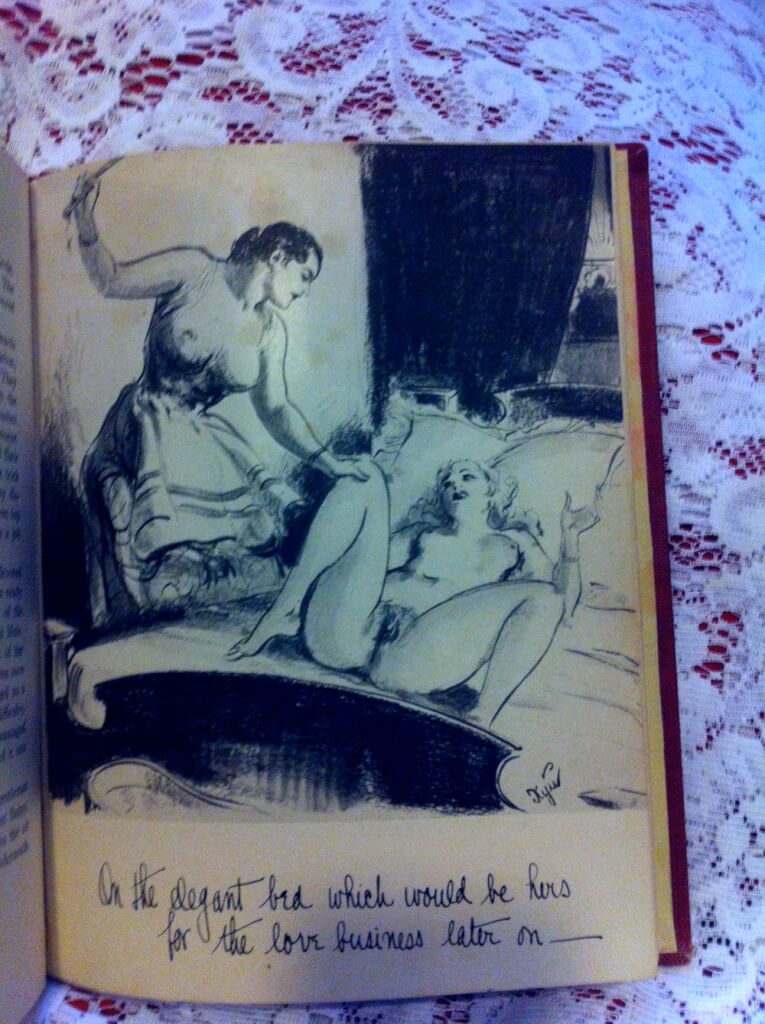
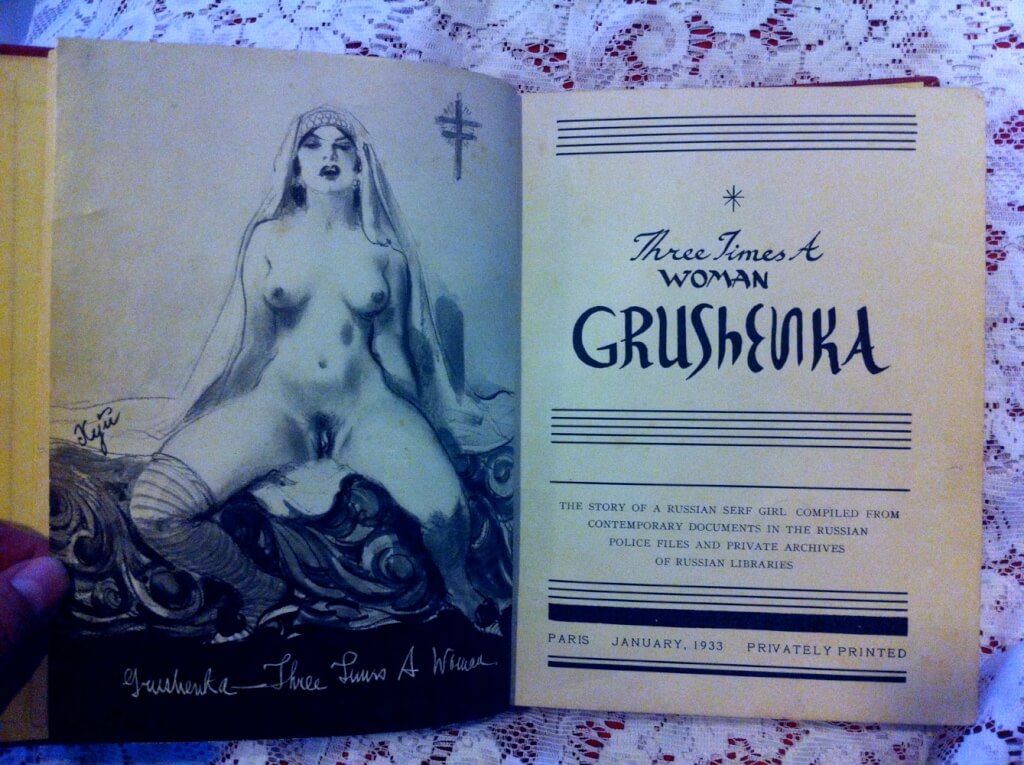 Three Times a Woman, Grushenka, anonymous [possibly Val Lewton?], illus. "a young Russian residing in Paris, who unfortunately must remain anonymous" (Privately Printed, London [New York], 1933) 9" X 7", 252pp, hardbound no DJ, red boards with gilt title on spine, good condition, minor wear and bumping, anonymous bookplate with the profile of a man made from many copulating couples. Title page reads: "The Story of a Russian Serf Girl Compiled from Contemporary Documents in the Russian Police Files and Private Archives of Russian Libraries" Originally published at New York in 1933 with a false Paris imprint. Val Lewton, the supposed author, was a well known film producer, responsible for a series of good low-budget horror movies in the 1940's by such directors as Robert Wise, Mark Robson and Jacques Tourneur. The book purports to be a flaggelation story written by a Russian living in Paris and then translated to english. The story takes place c. 1728, "shortly after the death of Peter the Great". The main character is Grushenka Pavlovsk. This edition is complete with very explicit illustrations.
Three Times a Woman, Grushenka, anonymous [possibly Val Lewton?], illus. "a young Russian residing in Paris, who unfortunately must remain anonymous" (Privately Printed, London [New York], 1933) 9" X 7", 252pp, hardbound no DJ, red boards with gilt title on spine, good condition, minor wear and bumping, anonymous bookplate with the profile of a man made from many copulating couples. Title page reads: "The Story of a Russian Serf Girl Compiled from Contemporary Documents in the Russian Police Files and Private Archives of Russian Libraries" Originally published at New York in 1933 with a false Paris imprint. Val Lewton, the supposed author, was a well known film producer, responsible for a series of good low-budget horror movies in the 1940's by such directors as Robert Wise, Mark Robson and Jacques Tourneur. The book purports to be a flaggelation story written by a Russian living in Paris and then translated to english. The story takes place c. 1728, "shortly after the death of Peter the Great". The main character is Grushenka Pavlovsk. This edition is complete with very explicit illustrations. -
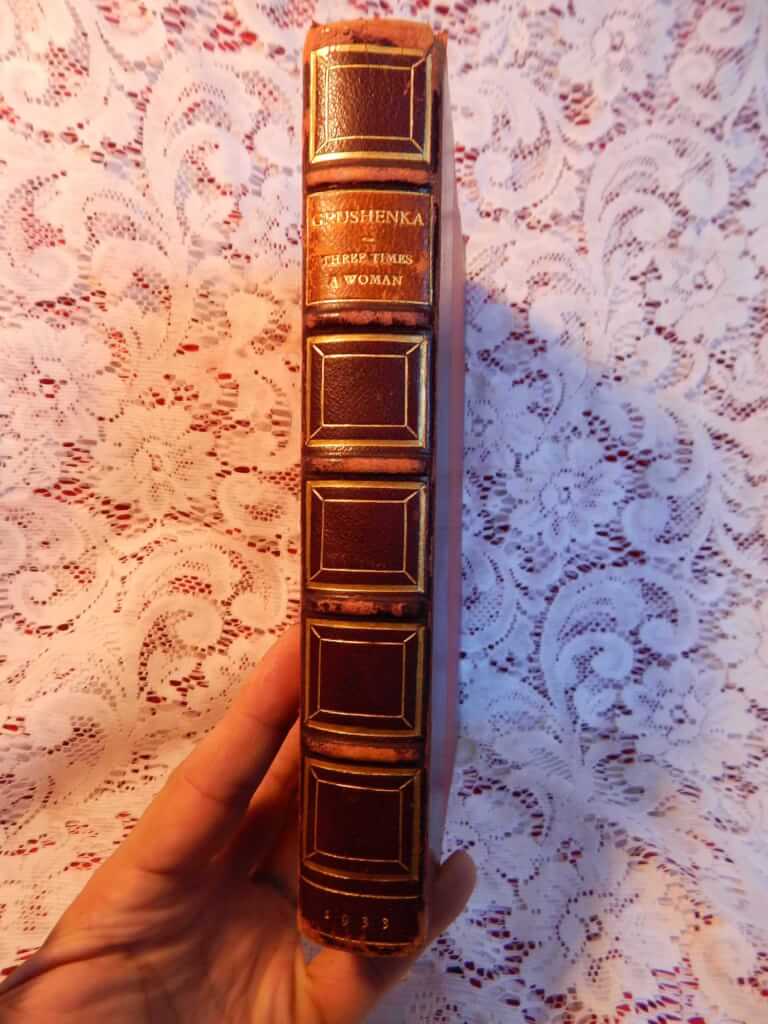
 Three Times a Woman, Grushenka, anonymous [possibly Val Lewton?], illus. "a young Russian residing in Paris, who unfortunately must remain anonymous" (Privately Printed, Paris [New York], 1933) 7.25"x9", 252pp, the original "french wraps" bound into hardcover, half red morocco over red boards, gilt titles and decorations on spine, 5 raised bands, gilt boarders on leather covers, top edge gilt, other edges deckled, frontispiece in color (rare), other illustrations not present, binding split at 18/19 to 30/31pp otherwise good condition, rubbing and bumping to boards Title page reads: "The Story of a Russian Serf Girl Compiled from Contemporary Documents in the Russian Police Files and Private Archives of Russian Libraries" Originally published at New York in 1933 with a false Paris imprint. Val Lewton, the supposed author, was a well known film producer, responsible for a series of good low-budget horror movies in the 1940's by such directors as Robert Wise, Mark Robson and Jacques Tourneur. The book purports to be a flaggelation story written by a Russian living in Paris and then translated to english. The story takes place c. 1728, "shortly after the death of Peter the Great". The main character is Grushenka Pavlovsk.
Three Times a Woman, Grushenka, anonymous [possibly Val Lewton?], illus. "a young Russian residing in Paris, who unfortunately must remain anonymous" (Privately Printed, Paris [New York], 1933) 7.25"x9", 252pp, the original "french wraps" bound into hardcover, half red morocco over red boards, gilt titles and decorations on spine, 5 raised bands, gilt boarders on leather covers, top edge gilt, other edges deckled, frontispiece in color (rare), other illustrations not present, binding split at 18/19 to 30/31pp otherwise good condition, rubbing and bumping to boards Title page reads: "The Story of a Russian Serf Girl Compiled from Contemporary Documents in the Russian Police Files and Private Archives of Russian Libraries" Originally published at New York in 1933 with a false Paris imprint. Val Lewton, the supposed author, was a well known film producer, responsible for a series of good low-budget horror movies in the 1940's by such directors as Robert Wise, Mark Robson and Jacques Tourneur. The book purports to be a flaggelation story written by a Russian living in Paris and then translated to english. The story takes place c. 1728, "shortly after the death of Peter the Great". The main character is Grushenka Pavlovsk. -
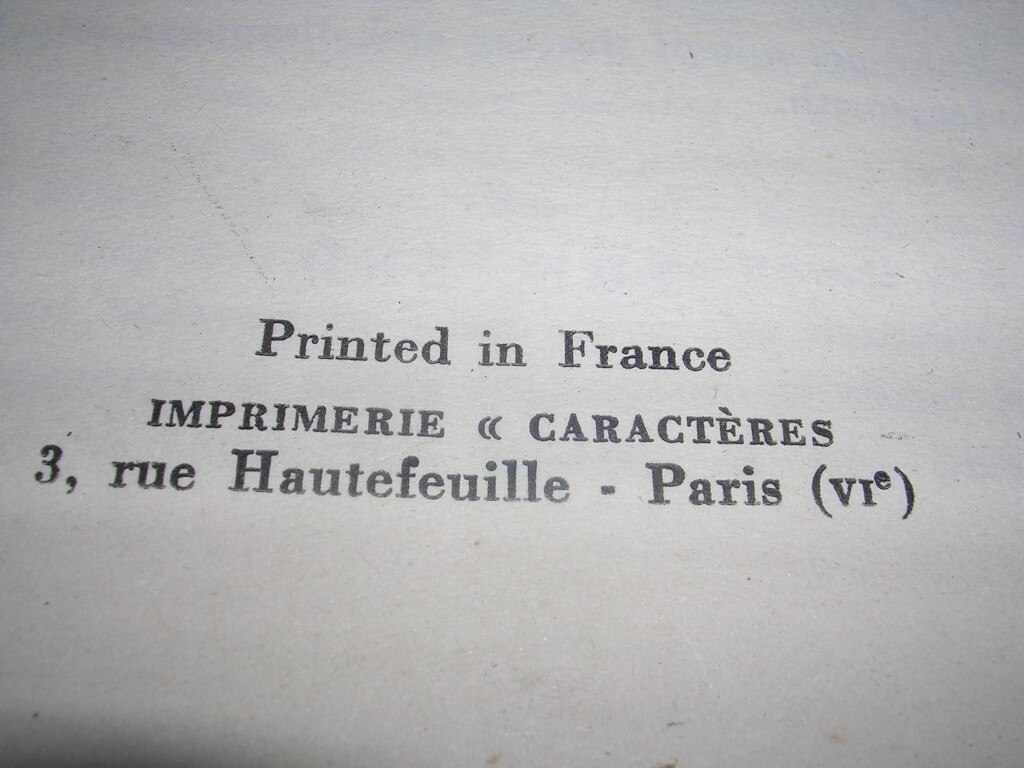
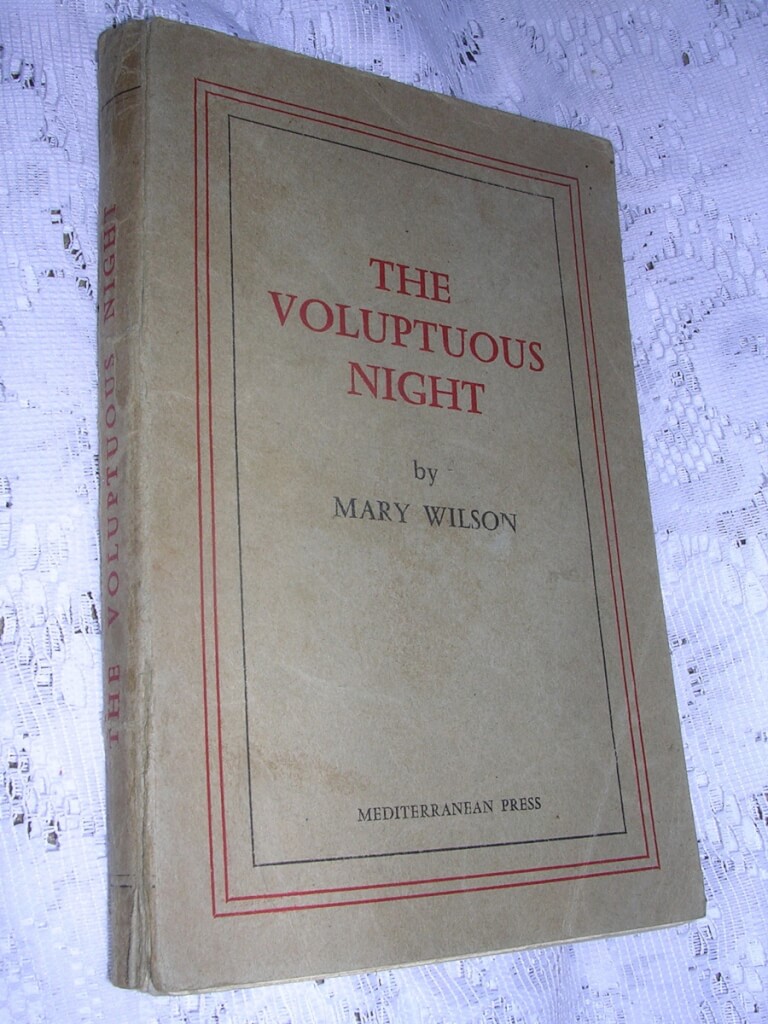 The Voluptuous Night, Mary Wilson (Mediterranean Press, Paris, 1957) 6 3/4" X 4 5/8", 167pp, soft bound, poor condition, covers soiled and detached According to James Campbell Reddie, this book is a translation of "La Nuit Merveilleuse" (a pornographic version of Vivant Demon's story "Point de Lendemain", 1777). It was published by various people including George Cannon c. 1830. This edition is a paperback from Paris in 1957. The back cover reads "Not to be imported into the United Kingdom or the U.S.A"
The Voluptuous Night, Mary Wilson (Mediterranean Press, Paris, 1957) 6 3/4" X 4 5/8", 167pp, soft bound, poor condition, covers soiled and detached According to James Campbell Reddie, this book is a translation of "La Nuit Merveilleuse" (a pornographic version of Vivant Demon's story "Point de Lendemain", 1777). It was published by various people including George Cannon c. 1830. This edition is a paperback from Paris in 1957. The back cover reads "Not to be imported into the United Kingdom or the U.S.A" -
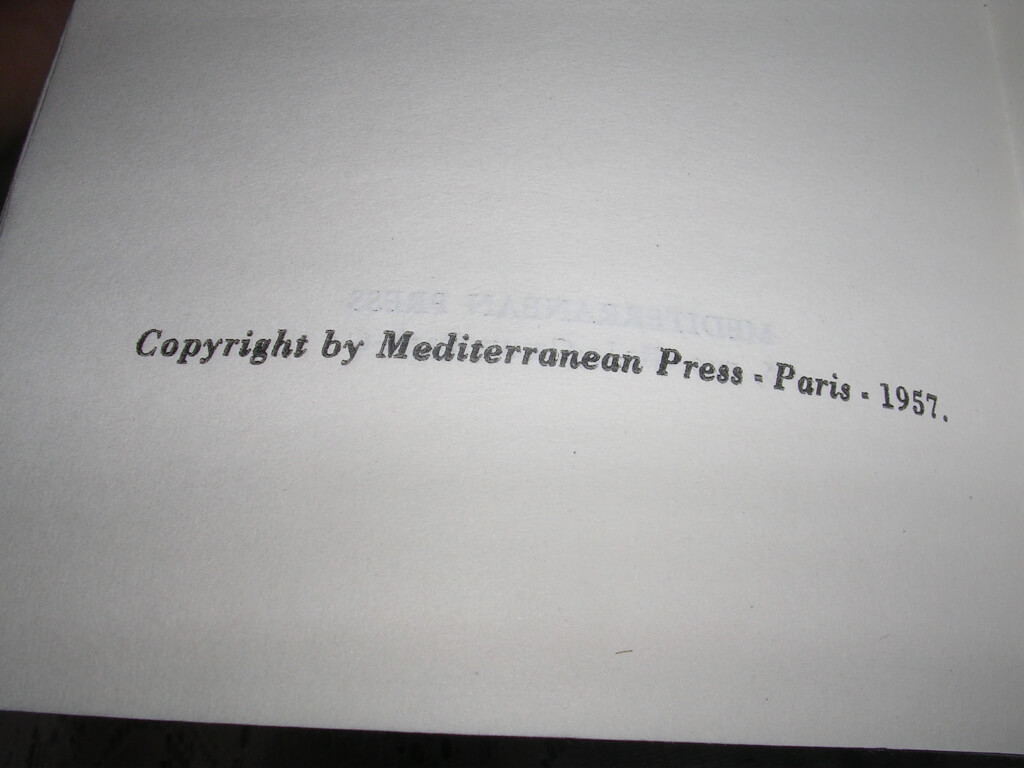
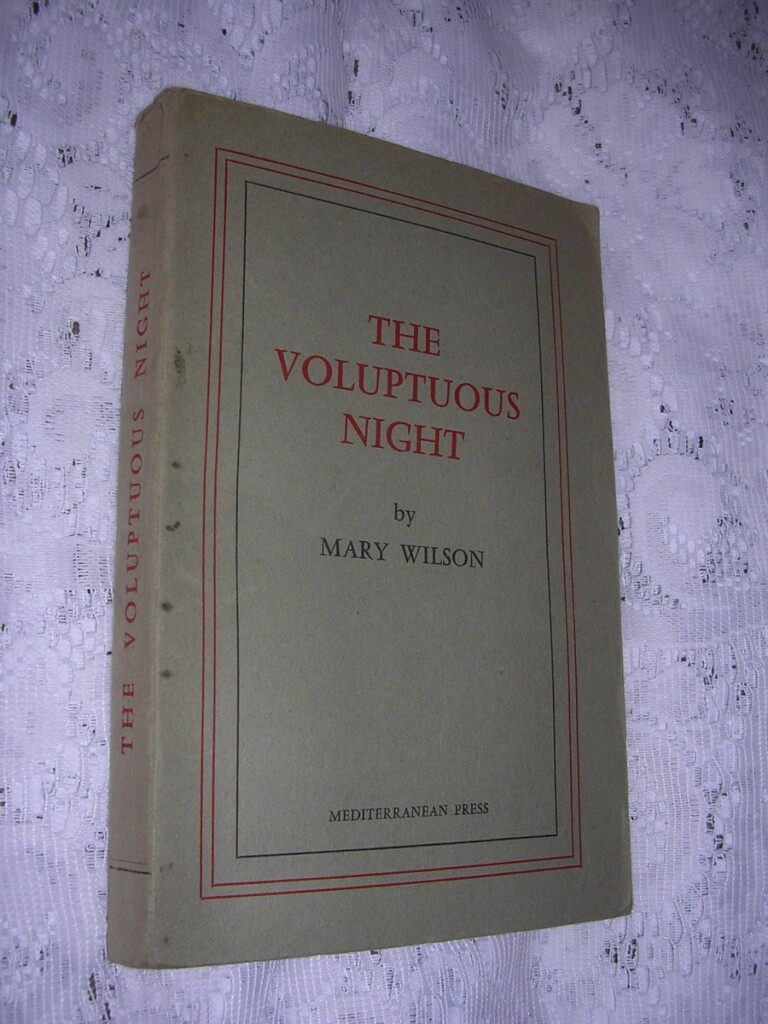 The Voluptuous Night, Mary Wilson (Mediterranean Press, Paris, 1957) 6 3/4" X 4 5/8", 167pp, soft bound, good condition, some soiling on covers According to James Campbell Reddie, this book is a translation of "La Nuit Merveilleuse" (a pornographic version of Vivant Demon's story "Point de Lendemain", 1777). It was published by various people including George Cannon c. 1830. This edition is a paperback from Paris in 1957. The back cover reads "Not to be imported into the United Kingdom or the U.S.A"
The Voluptuous Night, Mary Wilson (Mediterranean Press, Paris, 1957) 6 3/4" X 4 5/8", 167pp, soft bound, good condition, some soiling on covers According to James Campbell Reddie, this book is a translation of "La Nuit Merveilleuse" (a pornographic version of Vivant Demon's story "Point de Lendemain", 1777). It was published by various people including George Cannon c. 1830. This edition is a paperback from Paris in 1957. The back cover reads "Not to be imported into the United Kingdom or the U.S.A" -
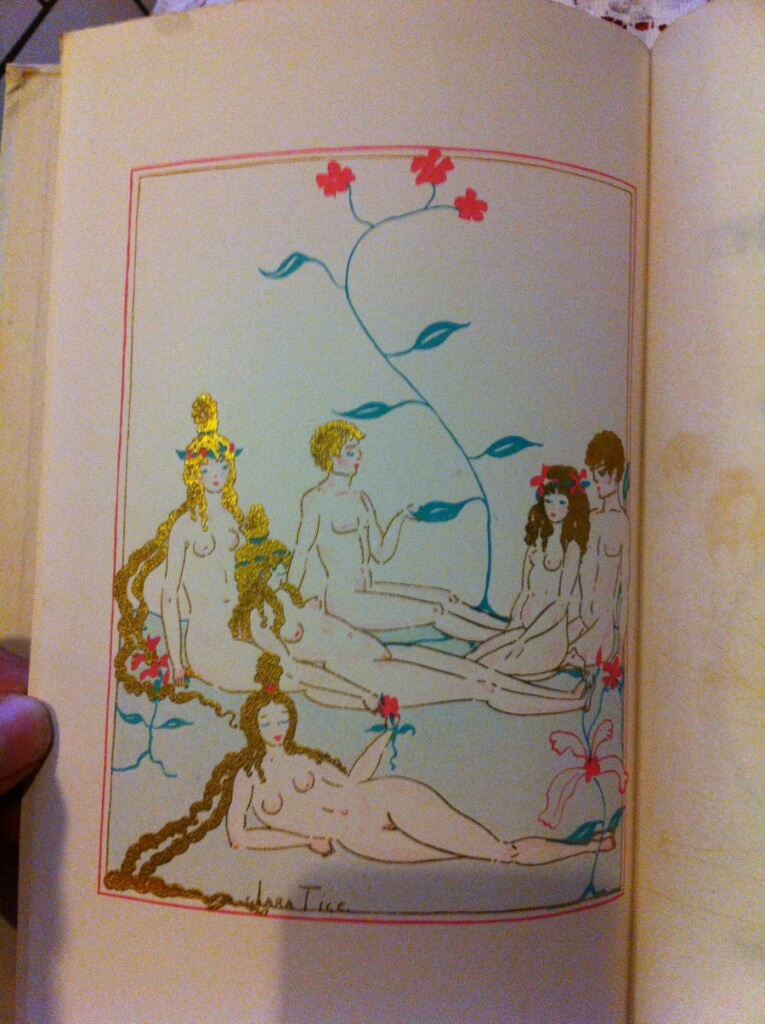
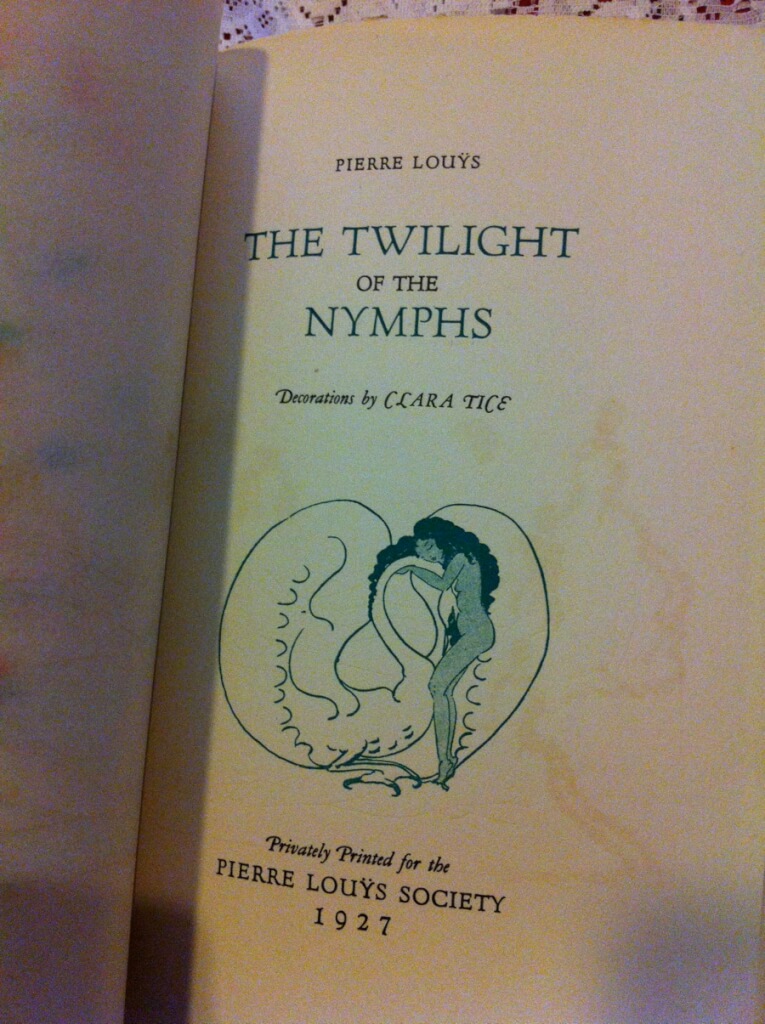 The Twilight of the Nymphs, Pierre Louys, illustrated by Clara Tice, "designed and supervised by Harry Cunningham" (The Pierre Louys Society, US, 1927, #682/990) 9.75" x 6.5", 235pp, white boards with silver gilt decorations on cover and spine, no dustjacket, fair condition, back boards loose but holding, pages clean. Pierre Louys (1870 - 1925) was a French poet and writer, most renowned for lesbian and classical themes in some of his writings. He is known as a writer who "expressed pagan sensuality with stylistic perfection." A collection of seven mildly erotic fables based on mythology. "This Edition Limited to 1250 copies of which 990 are for America, No. 682". 28 beautiful color illustrations by Clara Tice, all with tissue overlay and enhanced with gilt and silver.
The Twilight of the Nymphs, Pierre Louys, illustrated by Clara Tice, "designed and supervised by Harry Cunningham" (The Pierre Louys Society, US, 1927, #682/990) 9.75" x 6.5", 235pp, white boards with silver gilt decorations on cover and spine, no dustjacket, fair condition, back boards loose but holding, pages clean. Pierre Louys (1870 - 1925) was a French poet and writer, most renowned for lesbian and classical themes in some of his writings. He is known as a writer who "expressed pagan sensuality with stylistic perfection." A collection of seven mildly erotic fables based on mythology. "This Edition Limited to 1250 copies of which 990 are for America, No. 682". 28 beautiful color illustrations by Clara Tice, all with tissue overlay and enhanced with gilt and silver. -
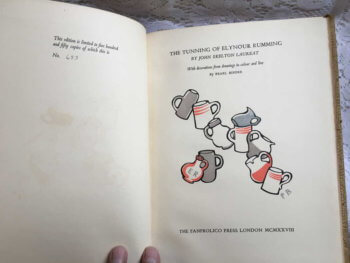
 The Tunning of Elynour Rumming, by John Skelton Laureat, "with decorations from the drawings in colour and line by Pearl Binder" (Fanfrolico Press, London, 1928, #433/550 hand written limitation) 7.75" x 11.25", 47pp, hardbound, coarse fiber on boards (burlap?), hand laid paper, artfully done, in good plus condition for age and for the unconventional binding materials The Tunning of Elynour Rummyng is a long raucous poem written by English poet John Skelton(1463-1529). The poem was first printed by Richard Lant sometime in 1550 and presents what many would consider disgusting images of rural drinking and drunkenness. For all its gritty description, Skelton has modeled the poem on Church liturgy of that time. The verse form itself closely resembles a liturgical chant. Elynour is a character in the poem who runs a "public house," or pub. Many pubs in England had the look of a home both inside and out. In the early 16th century, the male or female owner of the pub not only sold the ale, but also probably brewed it. Elynour easily acquires all her ingredients for quite acceptable ale from the local farmers in southern England where her pub was apparently located. Nevertheless, the kind of hard language which is found in the poem, is not uncommon as "bar talk." Today, much like in the 16th century, many brands of beer have been derisively referred to as "pig piss" perhaps because of beer's pale yellowish color and its bland and very slightly bitter taste. The poet says that chickens roost over Elynour's fermentation tank and drop their excrement into the froth. The yeast will sometimes form a white cap on the fermenting beer. Alcoholic beverages are also often associated with sex and indeed will sometimes reduce the inhibitions of men and women. However, Elynour advises her female customers that the ale will make them more desirable to their husbands, in part because she has the chicken excrement in the ale. Fanfrolico Press, Australia’s first ‘private press’ in the arts-and-craft tradition, was founded by Jack Lindsay, P. R. Stephensen and John Kirtley, originally in North Sydney in 1923. The press specialized in printings artful, limited editions of classics and forgotten works that were suited to the extravagant style of artist like his father, artist, sculptor and author Norman Lindsay who illustrated many of their books. Fanfrolico was scornful of modernism and with its florid style determinedly backward-looking. They did surprisingly well, despite the lack of business expertise of their young, ambitious "bohemian" owners, eking out a living despite the risky move to London in 1926 and upheavals in ownership that saw the departure in 1927 of Kirtley, and then Stephenson in 1929. Sometime in 1930 they published their last book.
The Tunning of Elynour Rumming, by John Skelton Laureat, "with decorations from the drawings in colour and line by Pearl Binder" (Fanfrolico Press, London, 1928, #433/550 hand written limitation) 7.75" x 11.25", 47pp, hardbound, coarse fiber on boards (burlap?), hand laid paper, artfully done, in good plus condition for age and for the unconventional binding materials The Tunning of Elynour Rummyng is a long raucous poem written by English poet John Skelton(1463-1529). The poem was first printed by Richard Lant sometime in 1550 and presents what many would consider disgusting images of rural drinking and drunkenness. For all its gritty description, Skelton has modeled the poem on Church liturgy of that time. The verse form itself closely resembles a liturgical chant. Elynour is a character in the poem who runs a "public house," or pub. Many pubs in England had the look of a home both inside and out. In the early 16th century, the male or female owner of the pub not only sold the ale, but also probably brewed it. Elynour easily acquires all her ingredients for quite acceptable ale from the local farmers in southern England where her pub was apparently located. Nevertheless, the kind of hard language which is found in the poem, is not uncommon as "bar talk." Today, much like in the 16th century, many brands of beer have been derisively referred to as "pig piss" perhaps because of beer's pale yellowish color and its bland and very slightly bitter taste. The poet says that chickens roost over Elynour's fermentation tank and drop their excrement into the froth. The yeast will sometimes form a white cap on the fermenting beer. Alcoholic beverages are also often associated with sex and indeed will sometimes reduce the inhibitions of men and women. However, Elynour advises her female customers that the ale will make them more desirable to their husbands, in part because she has the chicken excrement in the ale. Fanfrolico Press, Australia’s first ‘private press’ in the arts-and-craft tradition, was founded by Jack Lindsay, P. R. Stephensen and John Kirtley, originally in North Sydney in 1923. The press specialized in printings artful, limited editions of classics and forgotten works that were suited to the extravagant style of artist like his father, artist, sculptor and author Norman Lindsay who illustrated many of their books. Fanfrolico was scornful of modernism and with its florid style determinedly backward-looking. They did surprisingly well, despite the lack of business expertise of their young, ambitious "bohemian" owners, eking out a living despite the risky move to London in 1926 and upheavals in ownership that saw the departure in 1927 of Kirtley, and then Stephenson in 1929. Sometime in 1930 they published their last book. -

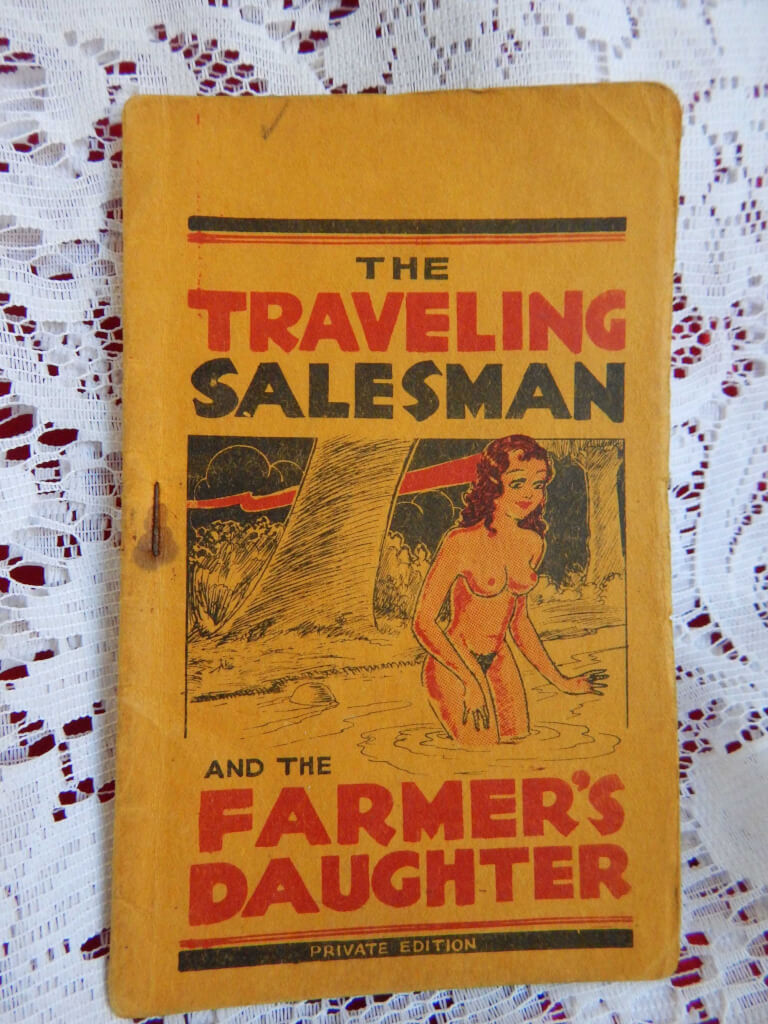 The Traveling Salesman and the Farmer's Daughter, (stated "Published by Fartgold Bros., Pokemyass, NY, 1935") 3.25" x 6", 16pp. pamphlet, stapled In the style of a "Tijuana bible" but larger and with 16 pages (instead of the traditional 8). Cover art and back cover in black and red. Tijuana bibles (also known as eight-pagers, bluesies, gray-backs, Jiggs-and-Maggie books, jo-jo books, Tillie-and-Mac books, and two-by-fours) were little pornographic comic books produced in the United States from the 1920s to the early 1960s.
The Traveling Salesman and the Farmer's Daughter, (stated "Published by Fartgold Bros., Pokemyass, NY, 1935") 3.25" x 6", 16pp. pamphlet, stapled In the style of a "Tijuana bible" but larger and with 16 pages (instead of the traditional 8). Cover art and back cover in black and red. Tijuana bibles (also known as eight-pagers, bluesies, gray-backs, Jiggs-and-Maggie books, jo-jo books, Tillie-and-Mac books, and two-by-fours) were little pornographic comic books produced in the United States from the 1920s to the early 1960s. -
Out of stock
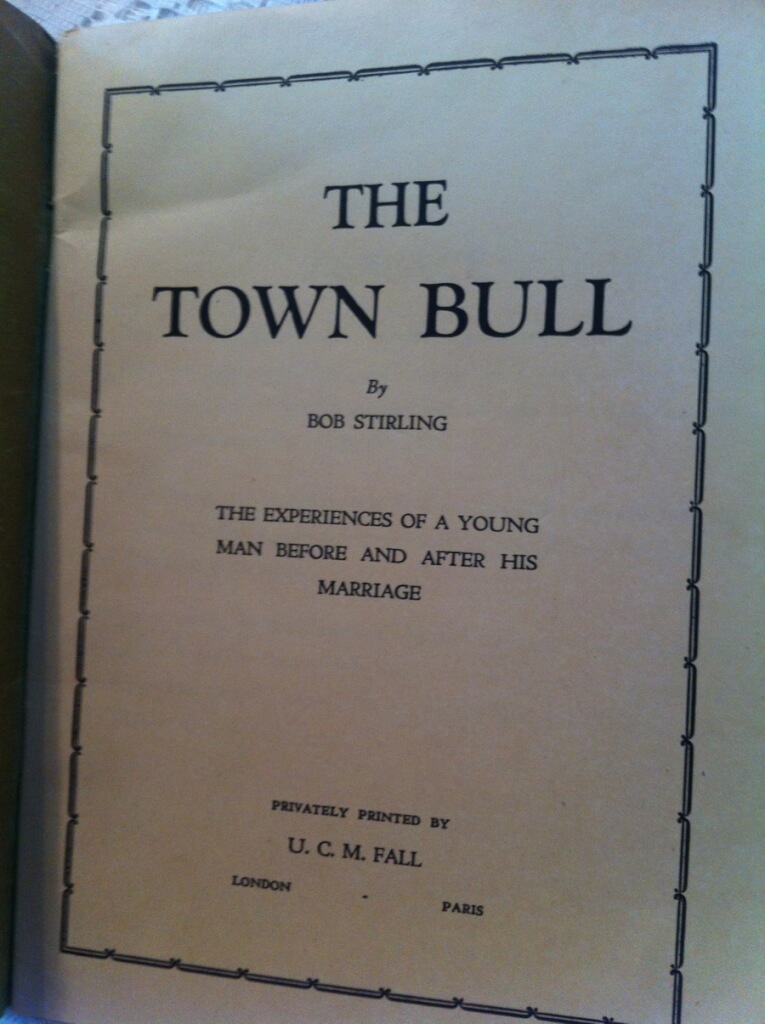
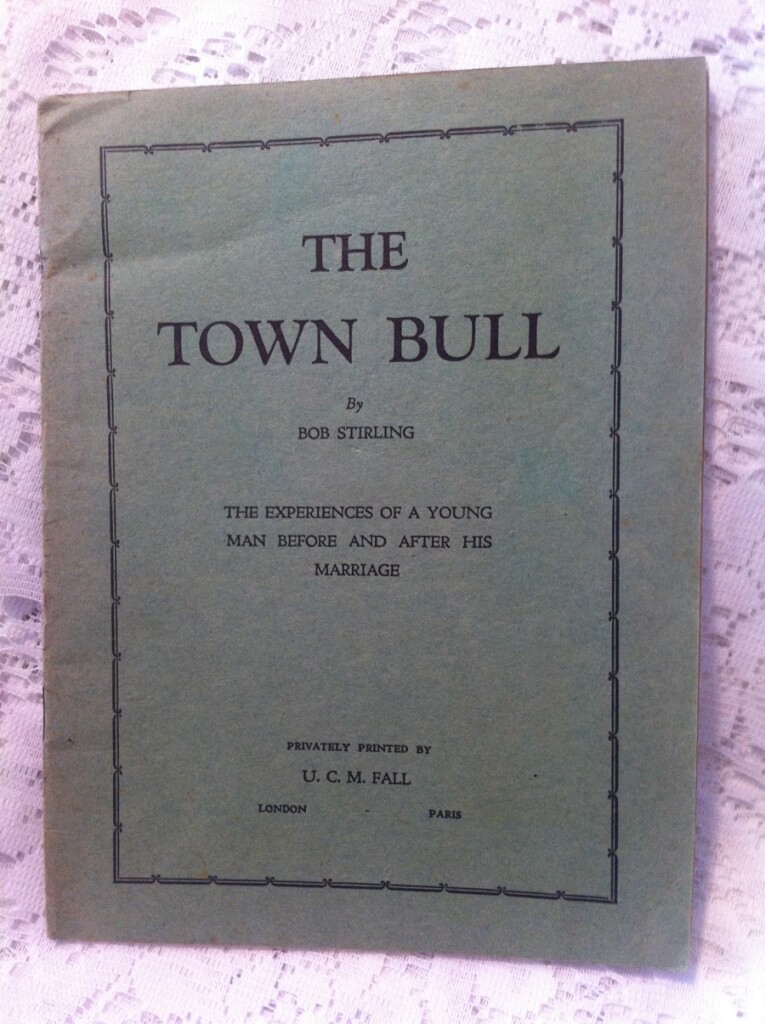 The Town Bull: the experiences of a young man before and after his marriage Bob Stirling, (Privately Printed by U. C. M. Fall, London, Paris,nd [false imprint. this is a pamphlet, not the book]) 7.25" x 5.5", 32pp., pamphlet, good condition, some fading Erotic story, no illustrations
The Town Bull: the experiences of a young man before and after his marriage Bob Stirling, (Privately Printed by U. C. M. Fall, London, Paris,nd [false imprint. this is a pamphlet, not the book]) 7.25" x 5.5", 32pp., pamphlet, good condition, some fading Erotic story, no illustrations -
 The Tales and Novels of Jean de La Fontaine | completely translated into English (Privately Printed, New York, 1929) 9.5"X6.25", xiii+250pp, x+329pp, hardbound with black boards and gilt titles on cover and spines, spine titles fading, top edge inked other edges deckled, good condition, illustrations throughout. Jean de La Fontaine (1621-1695) was a French fabulist and one of the most widely read French poets of the 17th century. After a long period of royal suspicion, he was admitted to the French Academy and his reputation in France has never faded since. Evidence of this is found in the many pictures and statues of the writer, as well as later depictions on medals, coins and postage stamps. The numerous works of La Fontaine fall into three traditional divisions: the Fables, the Tales and the miscellaneous (including dramatic) works. He is best known for the first of these, in which a tradition of fable collecting in French verse reaching back to the Middle Ages was brought to a peak. He published 245 fables, across twelve books between 1668 and 1694, exemplify the grace and wit of his age. Unlike many of his models, his fables function less as didactic tools and more as entertaining art. His beasts, humans, and plants are not merely moral-serving abstractions but rather lively actors in elegantly described escapades. Almost equally as popular in their time, his “tales”, Contes et nouvelles en vers (1665), is an anthology of various ribald short stories and novellas collected and versified from prose. They were particularly marked by their archly licentious tone. La Fontaine drew from several French and Italian works of the 15th and 16th centuries, among them The Decameron of Giovanni Boccaccio, Ludovico Ariosto’s Orlando Furioso, Antoine de la Sale’s collection Cent Nouvelles Nouvelles, and the work of Bonaventure des Périers.
The Tales and Novels of Jean de La Fontaine | completely translated into English (Privately Printed, New York, 1929) 9.5"X6.25", xiii+250pp, x+329pp, hardbound with black boards and gilt titles on cover and spines, spine titles fading, top edge inked other edges deckled, good condition, illustrations throughout. Jean de La Fontaine (1621-1695) was a French fabulist and one of the most widely read French poets of the 17th century. After a long period of royal suspicion, he was admitted to the French Academy and his reputation in France has never faded since. Evidence of this is found in the many pictures and statues of the writer, as well as later depictions on medals, coins and postage stamps. The numerous works of La Fontaine fall into three traditional divisions: the Fables, the Tales and the miscellaneous (including dramatic) works. He is best known for the first of these, in which a tradition of fable collecting in French verse reaching back to the Middle Ages was brought to a peak. He published 245 fables, across twelve books between 1668 and 1694, exemplify the grace and wit of his age. Unlike many of his models, his fables function less as didactic tools and more as entertaining art. His beasts, humans, and plants are not merely moral-serving abstractions but rather lively actors in elegantly described escapades. Almost equally as popular in their time, his “tales”, Contes et nouvelles en vers (1665), is an anthology of various ribald short stories and novellas collected and versified from prose. They were particularly marked by their archly licentious tone. La Fontaine drew from several French and Italian works of the 15th and 16th centuries, among them The Decameron of Giovanni Boccaccio, Ludovico Ariosto’s Orlando Furioso, Antoine de la Sale’s collection Cent Nouvelles Nouvelles, and the work of Bonaventure des Périers. -
Out of stock
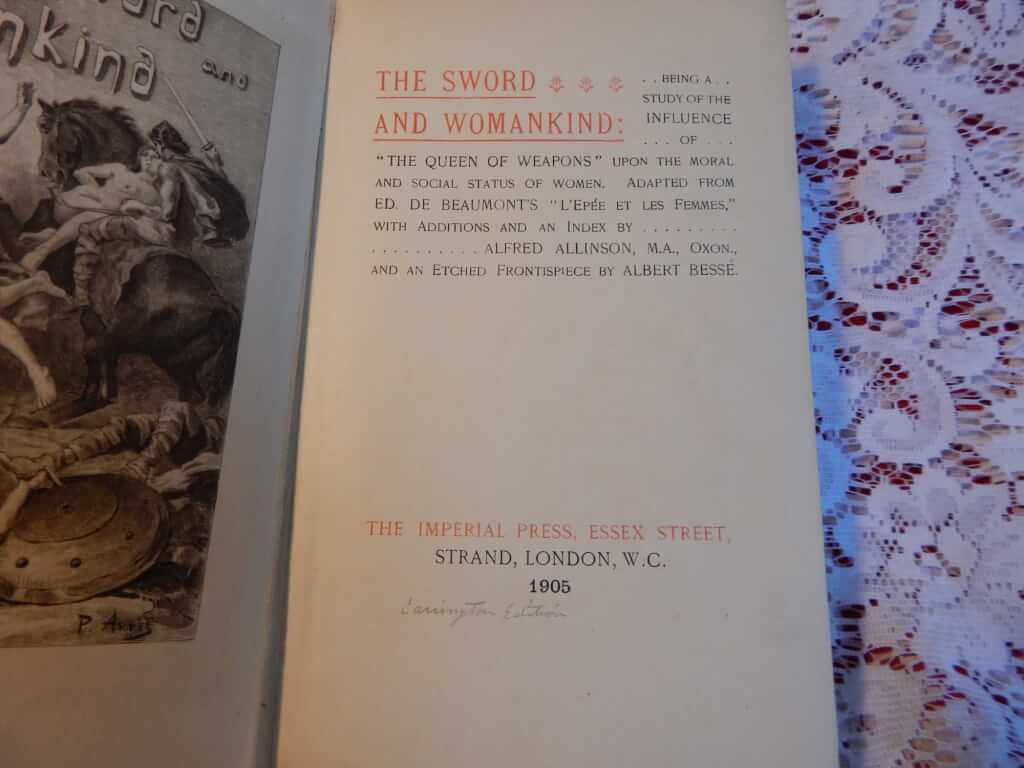
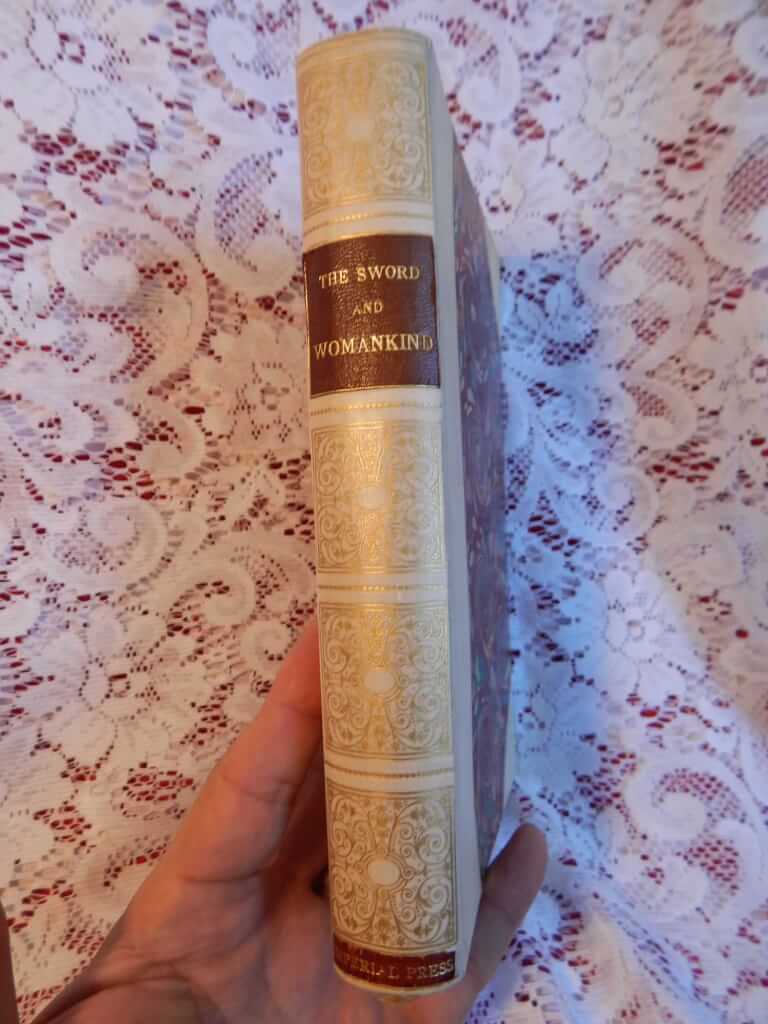 The Sword and Womankind: being a study of the influence of "The Queen of Wepons" upon the moral and social status of women. Adapted from Ed. de Beauont's "L'Epée et les Femmes," with addtions and an index by Alfred Allinson, M.A. Oxon., and an etched frontispiece by Albert Bessé, [frontispiece actually by Paul Avril, engraved by E. Leon] (The Imperial Press [Charles Carrington], Essex Street, Strand, London, W.C., 1905, #487/1000) 5.75"x8.75", xx+410pp, 1/2 while vellum over marbled boards, gilt title and decorations on spine, marbled endpapers, top edge gilt others deckled, frontispiece features a rare Paul Avril print and NOT Albert Bessé, numerous notes written lightly in margins in pencil, ribbon present, near fine copy, owner's ex libris stamp is evident on a few pages Beaumont, with a characteristic French point of view, believes in a feminine interpretation of history - which is, that all important historic events are caused by women. But unlike most Frenchmen he believed that all such events are caused by naughty women. This is a history of those women, adapted from the original French. Sample chapters: In barbarous ages woman is a divinity - Frea, the Scandinavian Venus; Swordsmen become the agents of women's sexual excesses - public defiances concerning harlots; Debauchery during the crusades - chivalry modified by oriental passions; New ways of love and dalliance - interest in salacious art. History of consequences of gender and sex including degradation of women, concubines, chastity belts, prostitutes, debauchery during crusades, erotic literature, duelists, cavaliers, orgies, etc. The book repeatedly advises that it is privately printed for subscribers only which was a legal fiction designed to get around obscenity laws prohibiting the public sale of such books. Édouard-Henri Avril (1849-1928) used the pseudonym “Paul Avril” for his erotic work. He was a French painter and commercial artist. His career saw collaboration with influential people like Octave Uzanne, Henry Spencer Ashbee and Friedrich Karl Forberg. He is one of the most celebrated erotic artists of his age. Avril was a soldier before starting his career in art. He was awarded with the Legion of Honour for his actions in the Franco-Prussian War.
The Sword and Womankind: being a study of the influence of "The Queen of Wepons" upon the moral and social status of women. Adapted from Ed. de Beauont's "L'Epée et les Femmes," with addtions and an index by Alfred Allinson, M.A. Oxon., and an etched frontispiece by Albert Bessé, [frontispiece actually by Paul Avril, engraved by E. Leon] (The Imperial Press [Charles Carrington], Essex Street, Strand, London, W.C., 1905, #487/1000) 5.75"x8.75", xx+410pp, 1/2 while vellum over marbled boards, gilt title and decorations on spine, marbled endpapers, top edge gilt others deckled, frontispiece features a rare Paul Avril print and NOT Albert Bessé, numerous notes written lightly in margins in pencil, ribbon present, near fine copy, owner's ex libris stamp is evident on a few pages Beaumont, with a characteristic French point of view, believes in a feminine interpretation of history - which is, that all important historic events are caused by women. But unlike most Frenchmen he believed that all such events are caused by naughty women. This is a history of those women, adapted from the original French. Sample chapters: In barbarous ages woman is a divinity - Frea, the Scandinavian Venus; Swordsmen become the agents of women's sexual excesses - public defiances concerning harlots; Debauchery during the crusades - chivalry modified by oriental passions; New ways of love and dalliance - interest in salacious art. History of consequences of gender and sex including degradation of women, concubines, chastity belts, prostitutes, debauchery during crusades, erotic literature, duelists, cavaliers, orgies, etc. The book repeatedly advises that it is privately printed for subscribers only which was a legal fiction designed to get around obscenity laws prohibiting the public sale of such books. Édouard-Henri Avril (1849-1928) used the pseudonym “Paul Avril” for his erotic work. He was a French painter and commercial artist. His career saw collaboration with influential people like Octave Uzanne, Henry Spencer Ashbee and Friedrich Karl Forberg. He is one of the most celebrated erotic artists of his age. Avril was a soldier before starting his career in art. He was awarded with the Legion of Honour for his actions in the Franco-Prussian War. -
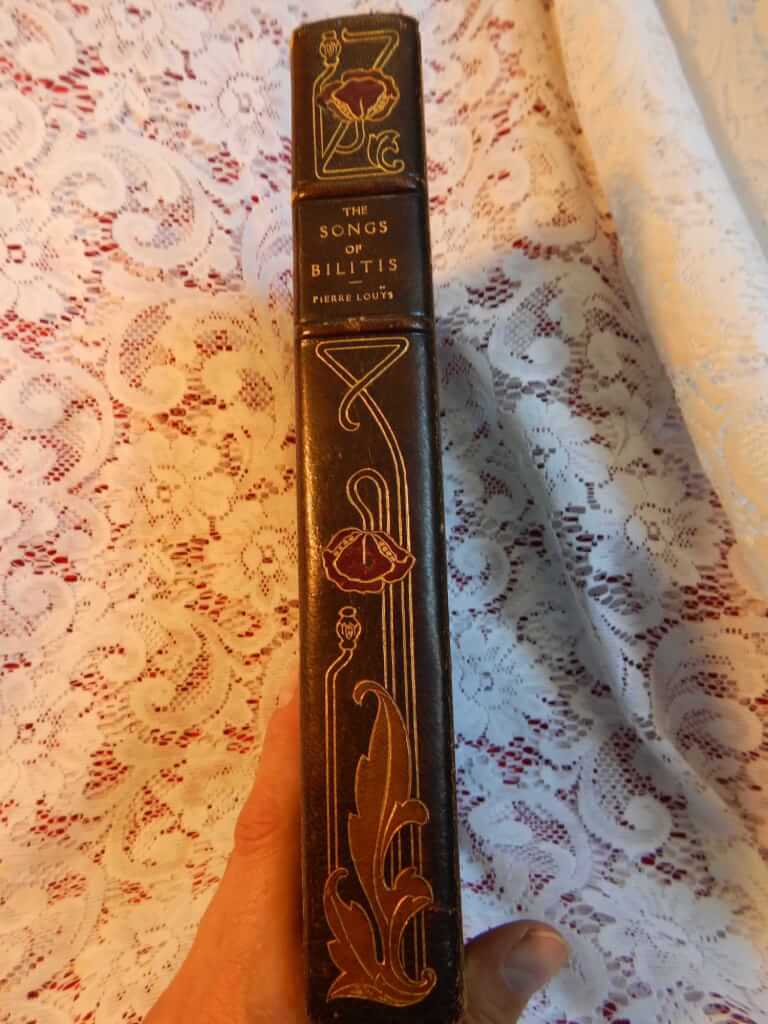
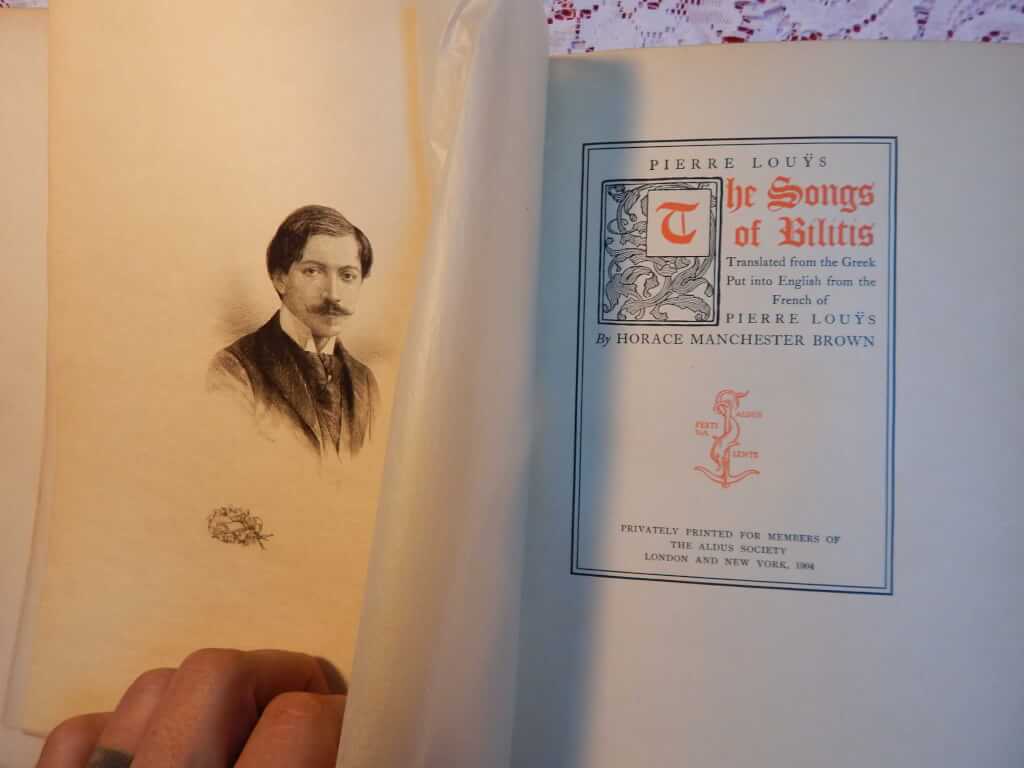 The Songs of Bilitis, Translated from the Greek, Put into English from the French of Pierre Louys by Horace Manchester Brown, illust. James Fagan (Privately Printed for Members of the Aldus Society, London and New York, 1904, #30/971) 7.25"x10.25", 341pp., 3/4 blue leather over blue boards, gilt decorations on boards, gilt titles and gilt and color decorations on spine, marbled boards, top edge gilt, other edges deckled, frontispiece portrait of author and two original etchings by James Fagan, good+ condition for age, some rubbing on spine and bumping to corners. Early (first?) translation of Les Chansons de Bilitis, rare and beautifully bound english translation of this classic in lesbian literature. The Songs of Bilitis (Les Chansons de Bilitis) is a collection of erotic, essentially lesbian, poetry by Pierre Louÿs published in Paris in 1894. Since Louÿs claimed that he had translated the original poetry from Ancient Greek, this work is considered a pseudotranslation. The poems are in the manner of Sappho; the collection's introduction claims they were found on the walls of a tomb in Cyprus, written by a woman of Ancient Greece called Bilitis, a courtesan and contemporary of Sappho to whose life Louÿs dedicated a small section of the book. On publication, the volume deceived even the most expert of scholars. Louÿs claimed the 143 prose poems, excluding 3 epitaphs, were entirely the work of this ancient poet — a place where she poured both her most intimate thoughts and most public actions, from childhood innocence in Pamphylia to the loneliness and chagrin of her later years. Although for the most part The Songs of Bilitis is original work, many of the poems were reworked epigrams from the Palatine Anthology, and Louÿs even borrowed some verses from Sappho herself. The poems are a blend of mellow sensuality and polished style in the manner of the Parnassian school, but underneath run subtle Gallic undertones that Louÿs could never escape. To lend authenticity to the forgery, Louÿs in the index listed some poems as "untranslated"; he even craftily fabricated an entire section of his book called "The Life of Bilitis", crediting a certain fictional archaeologist Herr G. Heim ("Mr. C. Cret" in German) as the discoverer of Bilitis' tomb. And though Louÿs displayed great knowledge of Ancient Greek culture, ranging from children's games in "Tortie Tortue" to application of scents in "Perfumes", the literary fraud was eventually exposed. This did little, however, to taint their literary value in readers' eyes, and Louÿs' open and sympathetic celebration of lesbian sexuality earned him sensation and historic significance.
The Songs of Bilitis, Translated from the Greek, Put into English from the French of Pierre Louys by Horace Manchester Brown, illust. James Fagan (Privately Printed for Members of the Aldus Society, London and New York, 1904, #30/971) 7.25"x10.25", 341pp., 3/4 blue leather over blue boards, gilt decorations on boards, gilt titles and gilt and color decorations on spine, marbled boards, top edge gilt, other edges deckled, frontispiece portrait of author and two original etchings by James Fagan, good+ condition for age, some rubbing on spine and bumping to corners. Early (first?) translation of Les Chansons de Bilitis, rare and beautifully bound english translation of this classic in lesbian literature. The Songs of Bilitis (Les Chansons de Bilitis) is a collection of erotic, essentially lesbian, poetry by Pierre Louÿs published in Paris in 1894. Since Louÿs claimed that he had translated the original poetry from Ancient Greek, this work is considered a pseudotranslation. The poems are in the manner of Sappho; the collection's introduction claims they were found on the walls of a tomb in Cyprus, written by a woman of Ancient Greece called Bilitis, a courtesan and contemporary of Sappho to whose life Louÿs dedicated a small section of the book. On publication, the volume deceived even the most expert of scholars. Louÿs claimed the 143 prose poems, excluding 3 epitaphs, were entirely the work of this ancient poet — a place where she poured both her most intimate thoughts and most public actions, from childhood innocence in Pamphylia to the loneliness and chagrin of her later years. Although for the most part The Songs of Bilitis is original work, many of the poems were reworked epigrams from the Palatine Anthology, and Louÿs even borrowed some verses from Sappho herself. The poems are a blend of mellow sensuality and polished style in the manner of the Parnassian school, but underneath run subtle Gallic undertones that Louÿs could never escape. To lend authenticity to the forgery, Louÿs in the index listed some poems as "untranslated"; he even craftily fabricated an entire section of his book called "The Life of Bilitis", crediting a certain fictional archaeologist Herr G. Heim ("Mr. C. Cret" in German) as the discoverer of Bilitis' tomb. And though Louÿs displayed great knowledge of Ancient Greek culture, ranging from children's games in "Tortie Tortue" to application of scents in "Perfumes", the literary fraud was eventually exposed. This did little, however, to taint their literary value in readers' eyes, and Louÿs' open and sympathetic celebration of lesbian sexuality earned him sensation and historic significance.













